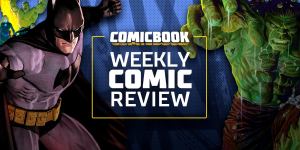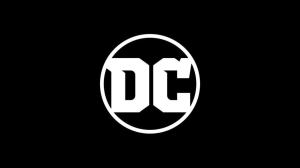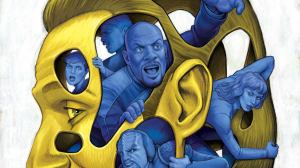
In just over a month, BOOM! Studios will roll out Joyride, from the creative team behind their best-selling Hacktivist series.
Videos by ComicBook.com
Here’s the idea: In the future, Earth sucks. The stars have been blocked out for so long that people have forgotten there was anything else besides the dumb World Government Alliance watching over them, training children to join the militarized Allied Youth and eliminating all resistance with a giant ray gun. Uma Akkolyte is a girl who shoots first and leaps before she looks, and when she gets a strange message from outside the barricades of SafeSky, she jacks a spaceship and punches through the stratosphere with an unlikely crew of teens who are totally not ready for what they’re about to find.
The creative team of Jackson Lanzing, Collin Kelly and Marcus To joined ComicBook.com to discuss the series, which debuts next month.
Joyride #1 hits the stands on April 13. Below, you can check out a five-page preview that’s running in the back of Mighty Morphin Power Rangers #1.
You guys took a pretty unconventional road to this series, teaming on high-profile books like Hacktivist and Maze Runner with Hollywood ties. Was it hard to sell BOOM! on a more traditional book?
COLLIN KELLY: One of the reasons we love working with BOOM! is because they’re never happy with the mundane. While both Hacktivist and Maze Runner came to us through, yes, very untraditional means, we’d argue that Joyride’s birth was no less strange. Lucky for us, BOOM! wanted more from this particular collaboration (Marcus, Jackson, and I); the trick came in convincing them that a high-speed, episodic space adventure going hard into the weird was the right path. Interestingly, the journey was actually part of a documentary all about Marcus’s art studio, The Royal Academy of Illustration and Design up in Toronto, and folks can check it out:
RAID STUDIOS from CKC on Vimeo.
JACKSON LANZING: Try pitching your new comic in front of a room of documentary cameras. It’s, uh, kinda nuts. But they bought it in the room and we started running forward. The beautiful thing about BOOM! is that with the success of books like Lumberjanes, The Midas Flesh, and The Woods, they were prepped for a YA space adventure story told with passion and humor. It’s basically right in their strike zone.
MARCUS TO: I knew they were gonna love it 🙂
I kind of love the treatment: in the future, the earth sucks. Would you say that sense of humor is representative of the comic itself?
LANZING: Absolutely. The first description we ever wrote for the book, when Uma and the gang were just splinters in the mind’s eye, was “being the return of episodic space opera through punk-rock teenage awesomeness.” We’ve made that the mission statement. Whenever we can turn the volume up to 11, we will. Whenever we can make ourselves laugh, we will. So the book may not be a comedy book, but it’s certainly meant to be a fun one.
KELLY: Our A+ goal is capture what it’s like to be a teenager, running towards whatever happens next: that means drama, sure, but it’s also about having a blast. Jack and I are making each other laugh all the time with this book, but then when Marcus steps up…Marcus has an amazing ability to take any one of our jokes and reduce it down to just a look that says everything we were trying for, but 1,000% better.
TO: One of the best parts about how we write this book is that I can totally read Jackson and Collin and see where the comedic beats can come in and really push it on the artwork side of things. We want our characters to have fun and not take themselves too seriously.
How has your creative relationship evolved as the team has worked together more, especially with such varied projects?
TO: From the first time I spoke with Jackson and Collin we got along. We totally understand each other’s sensibilities and that translates into how we work. We all listen to everyone’s ideas and always try to get the most out of the work we put in.
LANZING: Think of it like your favorite rock band. We did a couple albums and got our sea legs under us — that’s Hacktivist. We did a cover album — that’s Maze Runner. Then we went crazy and did our own thing. In the parlance of my favorite band, Radiohead, Joyride is our Kid A.
KELLY: With every project, there’s a different intention, a different energy. For Joyride, we’re trying to do as much of the heavy lifting as possible, so that we can give Marcus all the space possible to let loose, and just go art crazy. And trust me…Marcus To going art crazy is a beautiful thing.
Marcus is a hugely talented artist. I love his layouts. How much kind of experimenting are you guys doing with the art in Joyride?
LANZING: We made a deal with Marcus at the start of Hacktivist Vol 2. Essentially, we panel that book very specifically — we call every shot in the script — and having seen how incredible Marcus’ layouts were in Vol. 1, we wanted to push the envelope. So the deal was this: We’re going to give you absolutely insane layout challenges in Hacktivist — there’s a 32-panel, double-page spread in #5 — and when it comes to Joyride, we won’t give you a single layout. We’ll just give you the beats like a screenplay and you can interpret however you like. As the book’s proceeded, we look at it like playing in a band — we aren’t gonna tell Marcus how to solo on that guitar ’cause we don’t play like he does. Instead, we’re just gonna give him a beat and watch him shred.
TO: What I talked about with Jackson and Collin before we started on Joyride, is that I wanted to try and have a more open script to flex a creative muscle that sometimes gets pushed aside when doing licensed work. I wanted to experiment with my storytelling techniques to give the look of this book — and how it reads — more of me.
With Trump and Sanders running for President, the idea of revolutionary political change is in the air and very much a part of the discussion. How much do real-world things like that impact a story where you’re operating in an obviously fictional world, but touching on themes that are resonating outside of it?
LANZING: We started conceiving Joyride in 2014, well before Trump or Sanders were front-page news, but it certainly coincides with our story in a fascinating way. Trump’s “great wall” along the U.S. border to keep us safe sounds an awful lot like Joyride‘s SafeSky — a shell around Earth to keep us safe from the dangers of space. Uma’s desire to break through that wall — to adventure into the cosmos, encounter diversity, and better understand herself — is less the revolutionary drive pushed by Bernie Sanders than an evolution of Timothy Leary’s famed mantra: “Turn on, tune in, drop out.” Uma Akkolyte is in many ways the opposite of a person like Senator Sanders — she doesn’t want to change the system, she wants to run away and forget it ever existed — but as we learn more about her backstory, you’ll see some ties to today’s social movements and culture that run deep in her blood.
KELLY: It’s so funny that this book has begun to echo our current political system in such a real way; our intention here was always, after the hyper-grounded and political Hacktivist, to tell a story that raced as far away from that as possible. Which is, to be fair, still absolutely our intention. There is a time and place to become an active member of the voting public, but the future Earth that Uma finds herself trapped in is absolutely not that time or place.
What’s your favorite part of working on Joyride?
LANZING: That one’s easy: Getting to tell out-of-the-box space adventure stories with my two closest artistic collaborators — without anyone or anything telling us what to do. It’s the ultimate example of self-expression from the whole team, and I’m very proud to be a part of it.
TO: My favorite part is to just make things up. I get the chance to make up creatures, clothes, people, all on a whim. The freedom to do whatever we like.
KELLY: Day to day, I work with a lot of young people trying to figure out what they’re doing with their future. Today, one of them walked up to me — he had never read a comic before — and he told me he liked the preview. “Why?” I asked, curious. “Well,” he said, “I’m not in the future, and I’m not a girl… but my hometown is the worst, and I’m going to do whatever it takes to never go back.”
For me, that’s the best part of the book: telling a story that encourages people to reach for something better — not just settle for what’s close — and to go after what they want at full speed…no matter what.




